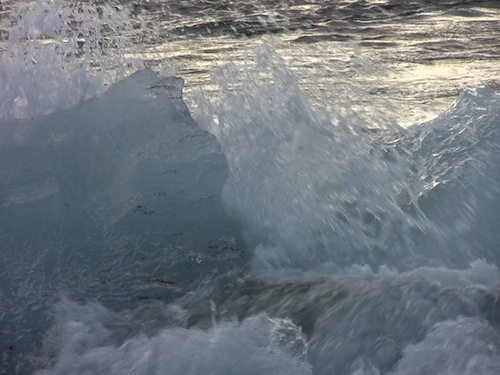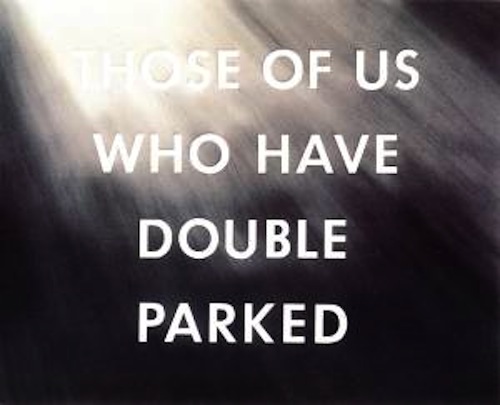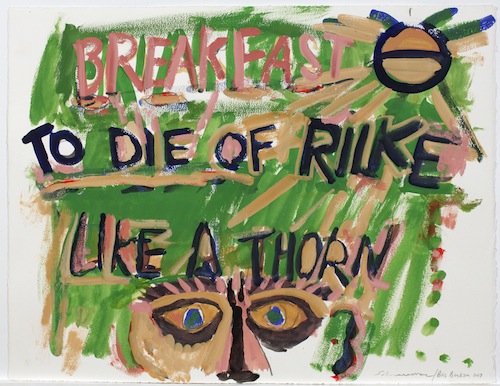
Any two meter square sheet of glass to lean against any wall.
—Lawrence Weiner
Years ago, I got this terrific note from Connie’s then new son-in-law Jim Hufford who had just heard me read my poems for the first time, in what may well have been his first poetry reading:
I suppose I was imagining something more like a Sphinixish, four-legs-in-the-morning kind of riddle. I tend to think of poetry as a sort of code game in which meaningful expressions and imitations of meaningful expressions are arranged in various patterns which give the impression of a unity of purpose, the impression of being “about something.” In other words, a charade. Or, better yet: Charades. Readers try to guess the author’s intentions in arranging strings of marks in a particular fashion (with the author guessing the same, I imagine). Both are caught in a kind of willing self-deception about the meaningfulness of the compilation of expressions in the poem.
In some sense, I would guess, poetry always involves this kind of puzzle—objects are presented and the reader is led into thinking there’s some special relation among them. Unlike the Sphinx’s riddles, though, these often don’t have answers. And, luckily, one needn’t worry about being strangled by a fierce and winged beast woman in the event of failing to find the answer.
Never mind that I have no interest in solving riddles, much less in posing them, I still find Jim’s account a fair one for the fact of poetry as it seems to a reader who is not in the habit of writing poetry himself.
I had an idea that a Man might pass a very pleasant life in this manner - Let him on a certain day read a certain page of full Poesy or distilled Prose, and let him wander upon it, and bring home to it, and prophesy upon it, and dream upon it: until it becomes stale - But when will it do so? Never - When Man has arrived at a certain ripeness in intellect any one grand and spiritual passage serves him as a starting-post towards all 'the two-and-thirty Palaces.' How happy is such a voyage of concentration, what delicious diligent Indolence!
—John Keats, to John Hamilton Reynolds, February 19, 1818
The amygdala is an almond shaped mass of nuclei located deep within the temporal lobe of the brain. It is a limbic system structure that is involved in many of our emotions and motivations, particularly those that are related to survival. The amygdala is involved in the processing of emotions such as fear, anger and pleasure. The amygdala is also responsible for determining what memories are stored and where the memories are stored in the brain. It is thought that this determination is based on how huge an emotional response an event invokes.
—Source forgotten
Sensation is usually thought to be confined to the pre-verbal; that is part of its glory, but as I continue to write, the feeling that poetry often returns words, the facts of each as it strikes one’s reading or listening consciousness, to that instantaneous sensation. This may be what Clark Coolidge means by the "inner physics" of words, and words together, as written, in the extended cyclotron. One may try, as Morton Feldman said of his music, “to hold the moment” at least for the duration of any particular instance, the word as struck. I also think this is implied in William Carlos Williams’s remark that a poem or any of its parts should constitute an event—“a revelation” is what he said—in the language.

Lawrence Weiner and Ed Ruscha are visual artists whose images are of words, usually amounting to one-liners, that ring out sensationally. Like word and thought balloons in comics, they are graphic representations that register tone, volume and some degree of attitude. With Weiner it is as if the wall itself was offering a benign suggestion (something exists, something that might be seen or done or both). Ruscha responds to words in the environment with a feeling of obligation, transmitting as an image what has been given him (by dint of its “power and rightness”) to see. Hands-on poet-painter collaborations, like those in Joe Brainard’s C Comics and the poster-like works Ted Berrigan, Ron Padgett, Anne Waldman and many others, including myself, did with George Schneeman, have a similar word-and-image amplitude, the words being set out as on-a-par, details of an overall image.

In poetry, for it to work, both reader and writer need to be aware that very word counts. A poem is built word for word, line for line, one then another, like frame by frame, shot by shot, in a film. Coincidentally, the analogy I’m after was anticipated by Stan Brakhage in a talk at MacDowell Colony in 1989:
The simplest definition of poetry that I know is you put one word after another, you’re not making a sentence to condemn somebody to your opinion. If you’re making a poem a single word counts and with filmmakers every 1/48th of second counts. So at any rate putting these things together, why can’t people see?
Without dictating an authoritative point of view, a poem can tell (like beads) the words—phrases to be turned here or there toward what might want to be uttered, or with your best shot, declared. That is part of poetry's sensational impact, where, at the edges of meaning, words return to their peculiar physicality, provocative then of unheard-of connotations. A poem’s coherence hangs by a thread. Beside creating a momentum, successive lines can be felt to knock against each other, or else they simply stack. A kind of pattern recognition, never exactly recognizably my own, takes charge, and it is this that sometimes defers or erases syntactic probity. Metamorphosis—the sense of being between aspects, a tumbling of available forms and meanings—makes pattern truer, if more complicated.
Berthold Brecht in his journals took up Wordsworth’s promise of a poem’s efficacy “to haunt, to startle, to waylay” and wondered at “a possible criterion …. does it enrich the individual’s capacity for experience?” & then goes on: “Poetry is never mere expression. Its reception is an operation of the same order as, say, seeing or hearing . . . a human activity, a social function of a wholly contradictory and alterable kind, conditioned by history and in turn conditioning it.” Samuel Johnson’s Lives of the Poets delivers a sequence as follows: “to tread upon the brink of meaning” [re Dryden]—“sudden elevations of mind”—“great increase of sensibility” [gotten from a poem]. Sensation is the condition of impact, face to face with being or actuality; the modern (and also traditional Asian) understanding of this is that it is sacred ground, primordial. Actuality is missing, missed most of the time. Sensation is in its way the showplace of beauty and also of what was realized and valued in modern discourse as The Sublime. Interestingly, this is not necessarily in sequence: what is beautiful is as often apprehended as such through recognition or perceiving. The mathematician Poincaré’s famous moment of realizing that a theorem he had worked up was correct, had to be, “because it was so beautiful” is an instance; so is T.S. Eliot’s saying of John Donne that a thought to him was a sensation (Eliot said “experience,” but, as with my misremembering of Williams's remark, I am translating to get closer to the bone) and that this is typical of the poetic turn of mind. Be that as it may, the issue of sensation, in art, anyway, seems primarily tied to appetite—literally, a taste for living, the desire (and hence, the will) to live.

Note: Variant parts of this text occur in the lecture text "Divine Conversation: Art, Poetry and the Death of the Addressee," For the Ordinary Artist (BlazeVOX, 2010)
Born in New York in 1939, Bill Berkson was a poet, critic, teacher and sometime curator, who became ...
Read Full Biography

